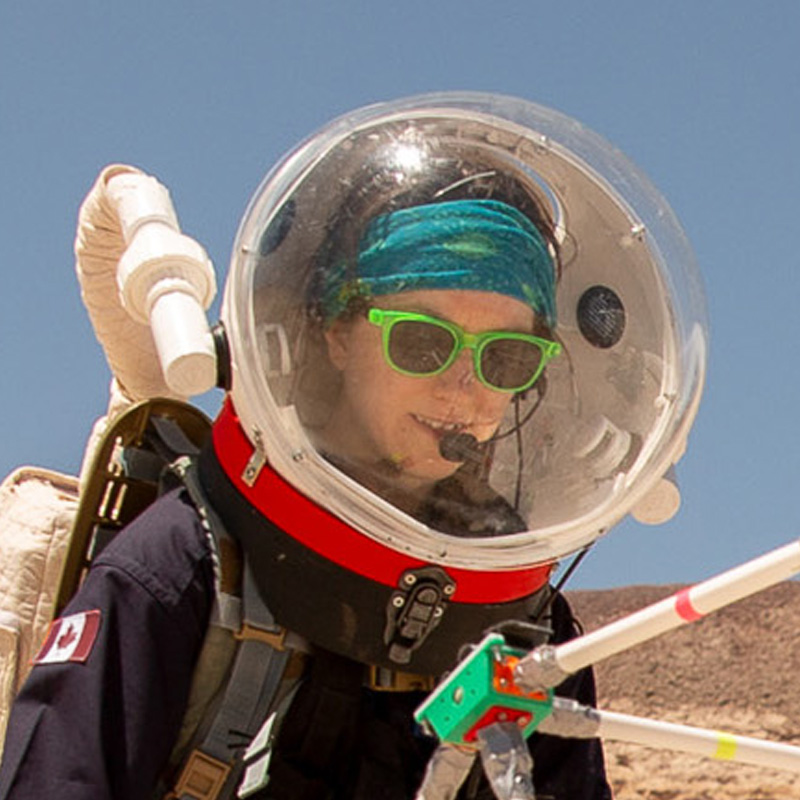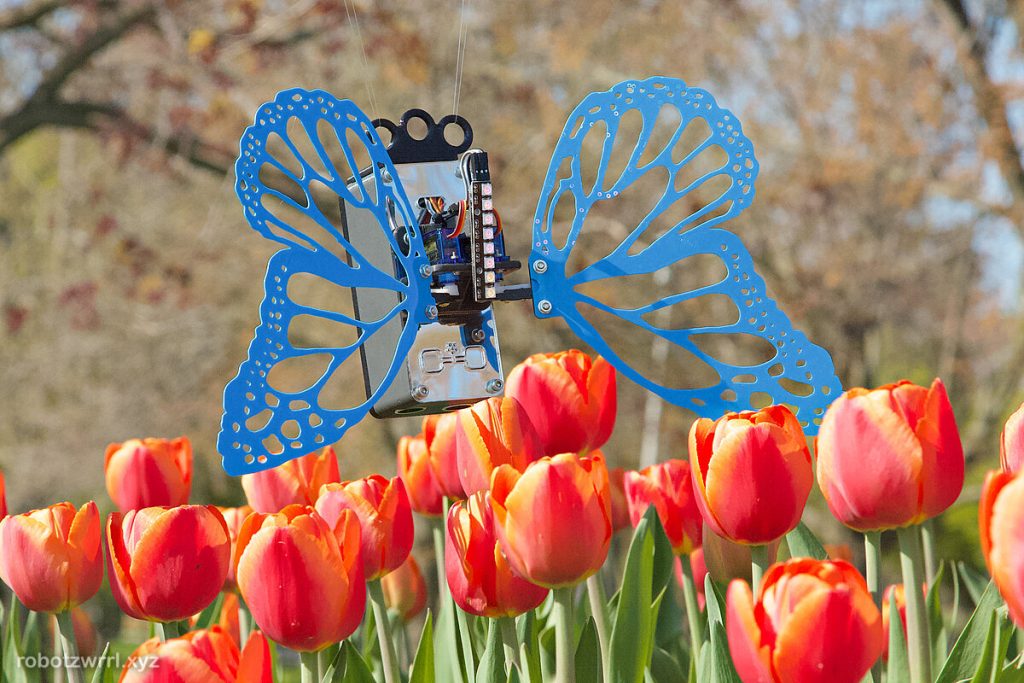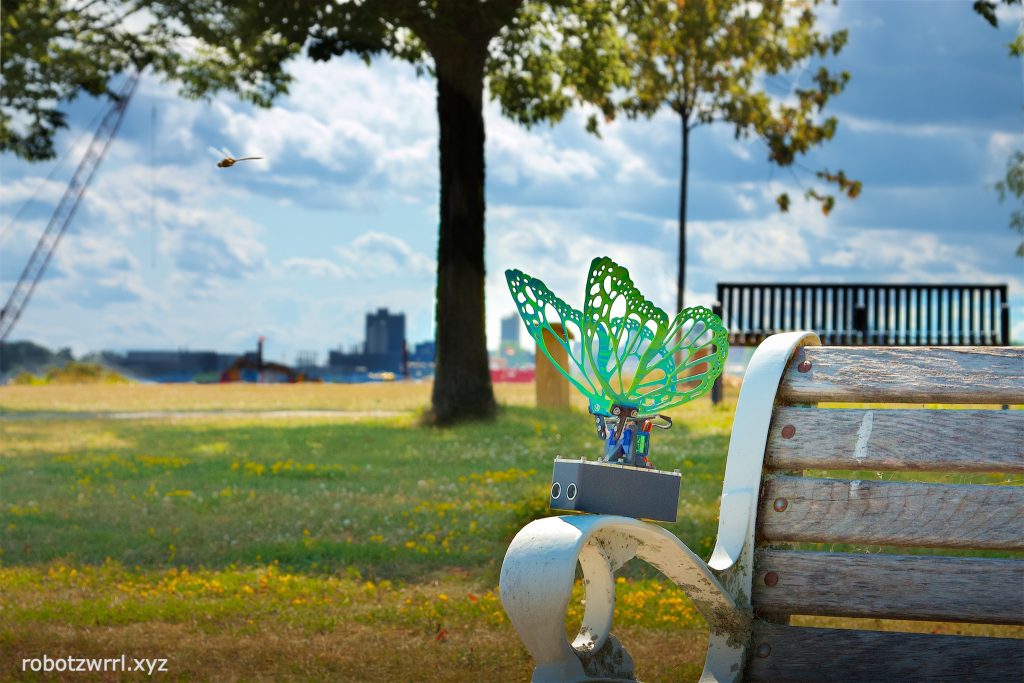Erin Kennedy: Where Wires Meet Wilderness

From the depths of kelp forests to the red soil at the Mars Desert Research Station, Erin Kennedy’s robots have tackled some of the toughest terrains out there. This robot inventor and analogue astronaut has designed robots that can be worn, pick up trash, collect sea urchins, and even conduct research in space. Now, Kennedy is bringing her newest robot, a motion-sensing butterfly, to the Tett Centre for her special edition project, Where the Wild Robots Are, as a part of the Kick and Push Festival. This hands-on interactive display brings together robotics and nature in an environment that fosters curiosity and wonder.
This interview has been edited for length and clarity.
How did your interest and journey into building robots begin?
When I was really young, I was injured from playing sports for a summer, so I needed something to keep me entertained and I got a LEGO robotics kit. I’ve been building robots ever since then.
My first robots were a few car-type robots. Then I got tired of wheeled robots, so I built one that dances using a slippery surface on its feet. Depending on which leg motor twists more, it moves in that direction. From there, I built even more robots without wheels, like one that was two pink bubbles, sort of like a snow person. It had googly eyes and a hat with a feather and motor that would spin around on its head. And a robotic bird, which ended up being my first product.
Are there any artists, creators, or pieces of media that have inspired or influenced your creative style?
I would say François Delarozière from Les Machines de l’île, which is in Nantes, France. They create these massive robots that are hydraulically and pneumatically actuated. They’re these massive creatures, and even though they’re massive, they still pay so much attention to the artistic detail. These movable sculptures have beautiful, intricate wood carvings and the way they made the mechanisms move is really beautiful.
There’s a huge interactive piece to this as well; they bring the robot sculptures out into the streets as part of public festivals, and they end up traveling along and interacting with people. For example, they had one exhibition in France, and the machine is so tall that it can see the upper levels of, say, an apartment building in France. The machine looks like a dragon, and it sprays water mist out of its nose, and then the people in their apartments are all surprised, and they get to participate from a different vantage point than on the ground.
It’s just incredible and inspiring that the vision for one person to create an interactive experience with mechanized creatures became this whole worldwide thing where they can bring their creatures anywhere for different special festivals and occasions.
Can you walk us through your creative process? How does an idea go from a spark of an idea to a fully functioning piece?
There are lots of ideas, and to choose which idea gets a lot of weight, I run it through a human-centered design process. I believe IDEO started a toolkit, and you can follow these different questions about: does it solve a pain point? What impact would it have? What does it address? Who would be using this? That sort of thing. So I like to narrow my ideas down that funnel, and then I look into how to be creative with technology to make it feasible.

Why butterflies for this project and not another winged animal?
We could have chosen dragonflies or bees, or ladybugs first, but we chose butterflies. I was really inspired by the iridescent wings of butterflies, and I thought it would be cool to try them. At the time, I was playing with this dual-colored 3D printer filament, and it’s similar in a way to iridescence.
You’ve built a lot of different robots over the years. Which was hardest to design, and which was the most fun? Why?
They all have their different quirks. Maybe Robot Butterfly was the trickiest to design so far, because I ended up using a real-time operating system instead of just bare metal for the firmware programming. That was a bit new compared to my previous robots.
The most fun one is probably a work in progress that I have. This robot will be going to inspect lava and look at geysers, maybe even volcanoes, too. To do that, I had to expand my material knowledge from just plastic to something else, and that ended up being ceramics. So I’ve had a lot of fun learning opportunities through learning at the Kingston Potters’ Guild classes.
Were there any moments during the creation of your project, Robot Butterfly, or any project that makes you laugh when you think of it? Why?
It’s funny sometimes when you upload code to Robot Butterfly and expect it to do one thing, but then it will do something else. Maybe its wing will completely go down, and then it lifts itself up and falls over. That’s pretty funny.
There’s been an awe-inspiring moment with Robot Butterfly, which was when I was taking nature photography for Robot Butterfly, and there happened to be a dragonfly that was zooming around. So I was like, “Man, if I could capture this photo, it would be incredible.” You just have to imagine all of the variables. This is an old camera, so it’s kind of slow. The dragonfly is super fast, and the robot’s wings are moving. I probably took thousands of photos, and I got one of them, and it’s just perfect with the dragonfly, and the robot with its wings open just the right amount.

Is there anything I haven’t asked that you wish I had? Or something you’d like to share?
The audience reading this may be in theater and performances, and they’re probably wondering, what on earth? Why are we reading about robots in a theater publication? How it relates is my previous robot, Bowie the Robot, picks up garbage on the beach. I wanted to get the community involved, so I would invite them out to these field tests—public gatherings on the beach—completely for free, and they could control the robot, learn how it works.
This took place for an entire summer. People in the community would join in, and come back every week to see how the robot evolved. Eventually, this became a public gathering. The community really got involved in it, so much so that at one point, the kids were really energetic, they wanted to control the robot so they formed a line on the beach to take turns controlling it to pick up garbage. Picking up garbage became a fun game, and that got me hooked into this idea of bringing robots outside into the public and seeing how they interact with them. We allow participants to pick up the robot, feel it in their hands, look at all the tech and wires, and see what happens when they move it around. So that’s how it relates to theater, it’s sort of an interactive performance. If readers were wondering, now they know.
Erin “RobotZwrrl” Kennedy is an eccentric robot maker and analogue astronaut based in Kingston, Ontario. Erin engages with local environmental stewards, both young and old, through a hands-on format by bringing the robots outdoors to the public, allowing participants to tangibly interact with the robots.
‘Where the Wild Robots Are’ runs from August 16-17, 2025, at the Tett Centre as part of the The Kick & Push Festival. More information about the program can be found here. You can learn more about Erin Kennedy on her Instagram or website.
